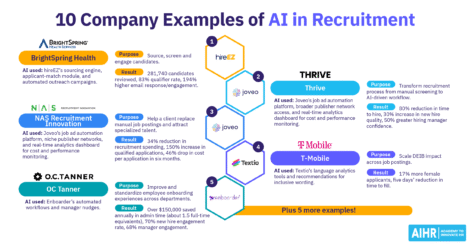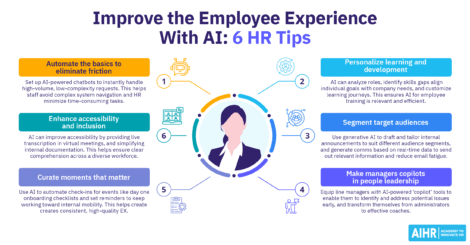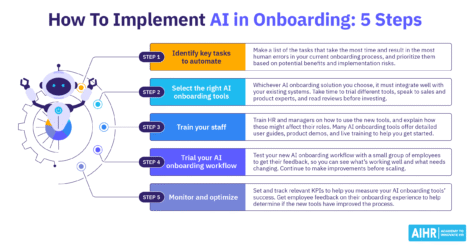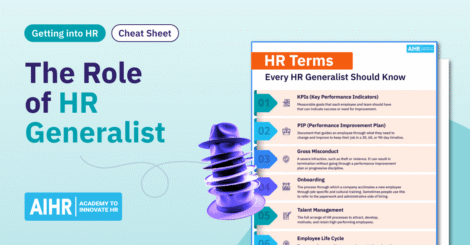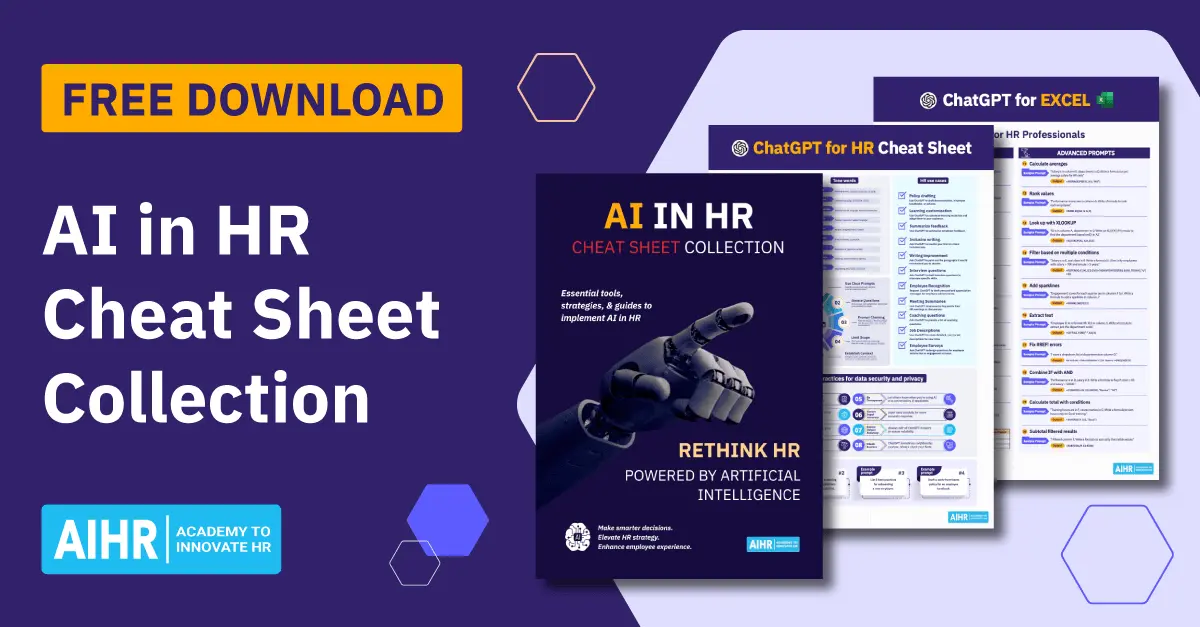AI onboarding is transforming how organizations welcome new hires and get them settled in. In fact, organizations using AI in employee onboarding solutions retain 82% more new hires and save more than $18,000 annually.
This article explores what AI onboarding entails, its impact on the employee experience, and how to initiate implementation within your organization to minimize new hire attrition and maximize employee retention rates.
Key takeaways
- Organizations using AI in onboarding see increased engagement and retention, lower costs, and significantly fewer hours spent on HR administrative tasks.
- AI can help automate routine HR tasks, personalize onboarding, predict and monitor engagement, and provide access to real-time analytics.
- Start by identifying repetitive tasks to automate, then choose integrated AI tools, train HR staff, pilot the system, and monitor results
- Always balance AI and automation with a human touch to maintain connection and culture.
Contents
What is AI onboarding?
How AI can improve onboarding
3 AI onboarding case studies
Top 11 AI onboarding tools for HR
5 steps to implement AI in onboarding
AIHR resources for HR professionals embracing AI
What is AI onboarding?
AI onboarding utilizes data and generative AI to automate and enhance key aspects of the onboarding process. AI tools can handle paperwork, such as verifying documents and ensuring the completion and accuracy of all required forms.
They can also analyze calendars to determine availability and schedule welcome and orientation meetings, as well as answer routine questions from new hires. Once a new employee starts, AI can support personalized training by assessing current skills, identifying knowledge gaps, and taking into account learning preferences.
AI onboarding will likely adapt to suit each employee’s needs, goals, and feedback. It will also support continuous learning and provide employees with more control over their learning paths, featuring on-demand coaching. At the same time, predictive analytics will help identify flight risks and estimate future performance, enabling companies to act early in developing and retaining top performers.
How AI can improve onboarding
Here are some crucial ways in which AI can strengthen the onboarding process:
Automate routine administrative tasks
New hire paperwork, account creation, equipment allocation, and compliance checks are time-consuming and repetitive tasks that divert HR’s attention away from higher-value work. Pre-fill and e-signature workflows, chatbots for FAQs, and HRIS integrations reduce manual work and errors. In fact, AI onboarding has cut HR involvement from 20 to 12 hours per new hire.
Personalize the newcomer experience
AI can analyze roles, departments, and learning preferences, then adapt the onboarding sequence accordingly. A remote web developer, for example, might receive technical guides and training on remote collaboration, while an in-office admin assistant might first see content on company culture and office procedures.
Predict and monitor engagement
Some AI tools can analyze digital communication patterns and onboarding progress to identify risks of disengagement or delay among new hires. HR and managers can then intervene early to offer targeted support or resources, preventing issues from escalating. This helps increase employee engagement and reduce early turnover.
Accelerate culture assimilation
From the moment a new hire signs their contract, AI can help them feel welcome and connected. It can:
- Pair them with a ‘buddy’
- Schedule virtual team introductions
- Curate a ‘Day 1 digest’ containing the company’s mission and values, and the new hire’s first-day schedule
- Use algorithms to determine the best times to communicate with the new hire.
Access to real-time analytics
AI-powered analytics offer clear insights into the onboarding journey. By tracking patterns in new hire behavior and metrics such as email open rates, training completion rates, chatbot interactions, and pulse survey feedback, you can refine content, timing, and channels. This enables you to resolve issues promptly, enhance onboarding, and tailor new hire support to foster stronger engagement.
3 AI onboarding case studies
Below are some real-life case studies of companies that have successfully implemented AI onboarding:
Case study 1: Hitachi
With almost 300,000 employees scattered worldwide, Hitachi struggled with onboarding all its new hires and keeping them engaged. Onboarding took 10 to 15 days to complete, involved numerous manual tasks (e.g., sending messages to IT to set up laptops), and didn’t allow new hires’ questions to be answered in real-time.
To address these issues, the IT department developed a private AI system and beta-tested it across various departments before scaling it for use in onboarding. This helped Hitachi reduce its onboarding time by four days, and HR involvement from 20 to 12 hours per new hire. The system can now also accurately answer new hires’ questions, giving them instant support.
Case study 2: Epiq
Epiq struggled with inconsistent manual onboarding processes across 18 countries. The company had to create and assign licenses and mailboxes manually, its hiring managers lacked visibility into the onboarding status of new hires, and spreadsheet-based tracking made its IT asset life cycle management overly complex.
With Power Automate, Microsoft Dataverse, and AI Builder, Epiq streamlined its entire onboarding process and integrated it seamlessly with its existing systems. This helped eliminate manual data entry tasks, provided new hires with faster access to tools, and reduced onboarding duration and costs.
Case study 3: A multinational Harbinger Group client
A multinational investment bank and financial services firm struggled with time-intensive onboarding, inefficient learning systems, dependency on costly experts, poor satisfaction rates, and low employee engagement. It approached Harbinger to automate its onboarding and learning processes, enabling it to deliver an efficient and seamless employee experience.
With AI-powered onboarding, the client was able to reduce its average time to resolve queries (from one to two hours per day to just 15 minutes) and decrease ticket escalation frequency by 15%. It also shortened onboarding time, reduced spending on external experts, and provided learning recommendations tailored to new hire profiles. This helped raise engagement and lower attrition.
Master AI use to improve your onboarding process
Learn to apply AI to your organization’s onboarding process to improve the employee experience, and drive engagement and retention.
With AIHR’s Artificial Intelligence for HR Certificate Program, will you’ll learn to:
✅ Apply AI solutions to improve HR productivity, effectiveness and decision-making
✅ Use AI to elevate people analytics, talent acquisition, and learning and development
✅ Learn best practices for using Gen AI safely, securely and ethically
Top 11 AI onboarding tools for HR
Below are 11 useful AI tools you can consider to help make your organization’s onboarding process more efficient, consistent, and productive:
1. Leena AI
- Best for: HR teams seeking a robust AI-powered HR service delivery platform.
- Top AI features: An agentic AI chatbot feature that’s available everywhere, connected to all HR systems, and follows set permissions.
- Pricing: Not publicly disclosed, but a free trial is available.
- Customer ratings: 4.5 on Gartner
- Learn more: Leena AI
2. Breezy HR
- Best for: Small to medium-sized companies seeking to automate their recruitment and onboarding processes.
- Top AI features: Ability to set up welcome messages, pre-boarding tasks, and culture introductions, and automation of task assignment.
- Pricing: Free for businesses with nine or fewer employees. For companies with 10 to 49 employees, prices start from $99 per month.
- Customer ratings: 4.5 on Capterra
- Learn more: Breezy HR
3. Monday.com`
- Best for: Organizations looking for a multi-purpose AI tool to manage onboarding and other projects.
- Top AI features: Data categorization and organization, key information extraction from files, sentiment detection, complex topics summaries, translation capabilities, and custom blocks to create AI automation tailored to your workflow.
- Pricing: Free for up to two seats. The standard pricing tier begins at $14 per seat per month (billed annually).
- Customer ratings: 3.1 on Trustpilot
- Learn more: Monday.com
4. Enboarder
- Best for: Delivering structured, personalized onboarding and employee life cycle experiences at scale.
- Top AI features: An AI journey builder, personalized welcome messages, cross-functional alignment, real-time reports, and prompts and coaching for hiring managers.
- Pricing: Customized quote available on request.
- Customer ratings: 4.9 on Capterra
- Learn more: Enboarder
5. Talentech
- Best for: Organizations seeking a solution to handle preboarding, onboarding, reboarding, crossboarding, and offboarding.
- Top AI features: Custom onboarding journeys, simple task management, powerful automations through interactive workflows, a digital chatbot, pre-scheduled email prompts, auto-prompt task notifications, and engaging learning and feedback.
- Pricing: Customized quote available on request.
- Customer ratings: 4.5 on Capterra
- Learn more: Talentech
6. BambooHR
- Best for: Companies looking for a centralized, easy-to-use HR platform.
- Top AI features: Automated and personalized emails sent at every stage, eNPS topic summaries, AI-summarized feedback, Ask BambooHR to answer employee questions, and AI-generated peer groups for comparisons.
- Pricing: Starts at just $10 per month per employee.
- Customer ratings: 4.6 on Capterra
- Learn more: BambooHR
7. Workday
- Best for: Organizations looking for a unified platform to manage HR, finance, legal, and operations in one place.
- Top AI features: HR onboarding automation that guides new hires through onboarding tasks, insights into skills gaps, and a talent mobility agent that suggests learning and training content for employees.
- Pricing: Customized quote available on request.
- Customer ratings: 3.9 on Comparably
- Learn more: Workday
8. Rippling
- Best for: Businesses looking to run their workforce more efficiently and empower their employees.
- Top AI features: Automate admin tasks, smart access controls to help employees move faster, new hires automatically set up with the apps and devices they need, insights and analytics with custom reports. New recruits can be onboarded in 90 seconds.
- Pricing: Starting at £7 per user per month
- Customer ratings: 4.6 on Trustpilot
- Learn more: Rippling
9. HiBob
- Best for: Companies looking for a modern HRIS that focuses on culture and engagement.
- Top AI features: Automated onboarding flows and personalized onboarding.
- Pricing: Customized quote available on request.
- Customer ratings: 4.4 on Trustpilot
- Learn more: HiBob
10. Gusto
- Best for: Small and medium-sized businesses.
- Top AI features: Personalized offer letters, custom onboarding checklists, software provisioning, document sending, and signing of documents instantly from anywhere.
- Pricing: Plans start from $49 per month, plus an additional $6 per month per person.
- Customer ratings: 4.6 on Capterra
- Learn more: Gusto
11. Greenhouse
- Best for: Early-stage businesses, scaling companies, and enterprises looking for a complete hiring solution.
- Top AI features: Onboarding goal setting and tracking, predetermined actions for different roles and offices, an information and resource hub, automated tasks and email flows, and reports about onboarding trends.
- Pricing: Customized quote available on request
- Customer ratings: 4.5 on Capterra
- Learn more: Greenhouse
5 steps to implement AI in onboarding
Here are five practical steps to help you implement AI for onboarding new employees:
Step 1: Identify key tasks to automate
Create a list of tasks that consume the most time and result in the most human errors in your current onboarding process, and prioritize them based on potential benefits and implementation risks. Involve HR, hiring managers, and IT to identify bottlenecks and pain points, and estimate the time and cost savings that can be achieved by automating each task.
Step 2: Select the right AI onboarding tools
You may need only one AI onboarding tool, or a few different tools to achieve your onboarding goals. Certain solution providers may be able to customize technologies to suit your business needs. Regardless of the AI onboarding solution you choose, it must integrate seamlessly with your existing systems. Take the time to trial different tools, speak with product experts, and read reviews before making an investment.
Step 3: Train your staff
Prepare your HR team, hiring managers, and IT support well before rolling out AI onboarding at scale. To achieve this, you must train HR and managers on how to utilize the new tools and explain how these tools may impact their roles and responsibilities. Many AI onboarding tools offer detailed user guides, product demos, and live training to help you get started.
Step 4: Trial your AI onboarding workflow
Test your new AI onboarding workflow with a small group of employees to get their feedback, so you can see what’s working well and what needs changing. Track quantitative metrics, such as time spent on manual tasks, number of errors, completion rates for forms and training, and time to full productivity. Then, continue to make improvements before scaling.
Step 5: Monitor and optimize
Set and track relevant KPIs to help you measure the success of your AI onboarding tools. For example, you may want to track the number of errors that occur with automation versus those that occur in the manual system. At the same time, get regular employee feedback on their onboarding experience to help determine if the new tools have improved the process.
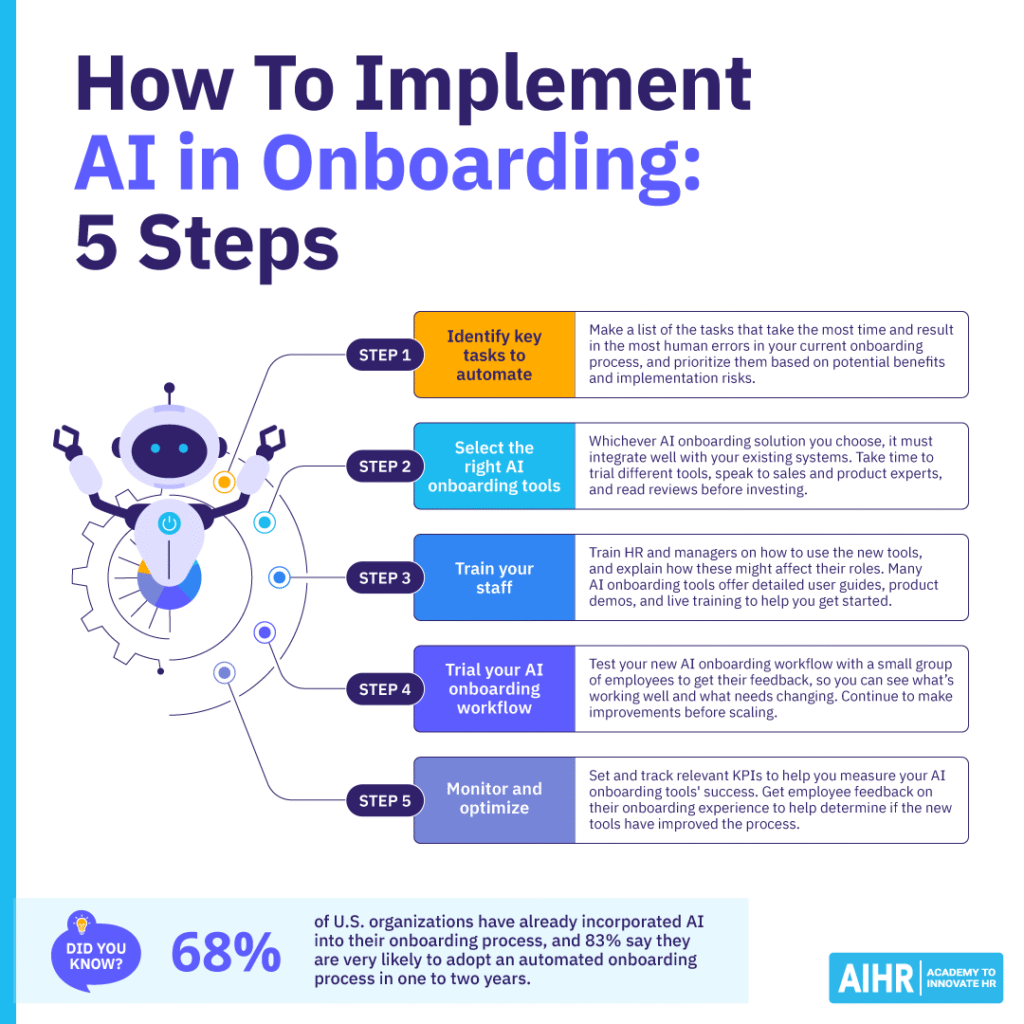
AIHR resources for HR professionals embracing AI
Below are some AIHR resources that can equip you with the skills and knowledge you need to effectively incorporate and implement AI into your HR processes, including employee onboarding.
Certificate programs / online courses
The Artificial Intelligence for HR Certificate Program equips you with the skills needed to effectively integrate AI into processes, like onboarding, making them more engaging and personalized. The program also emphasizes the importance of balancing technology with proven HR practices, ensuring employees feel valued and supported throughout their onboarding.
Useful articles and resources
The following AIHR Blog articles can help increase your knowledge of AI’s applications in HR:
- AI in HR: A Comprehensive Guide
- AI and Automation in HR: Impact, Adoption and Future Outlook
- 19 Best Onboarding Process Examples To Inspire You
Next steps
Start by auditing your current onboarding process. Map each step, from contract signing to the end of probation, and note where delays, errors, or manual work cause issues for new hires and HR. Use this to define clear goals for AI, and involve HR, hiring managers, IT, and key stakeholders early to align on priorities, data needs, and risks.
Then, shortlist a small set of AI tools that integrate with your HRIS, and pilot them with one function, location, or new hire group. Train HR and managers on the new workflows, track both hard metrics (e.g., time saved, error reduction, and completion rates) and soft metrics (e.g., new hire feedback and manager satisfaction), and use these insights to refine your setup.
Once the pilot delivers results, build a business case for broader rollout and plan a phased implementation, with ongoing measurement and improvements to keep your AI onboarding effective and employee-centric.










